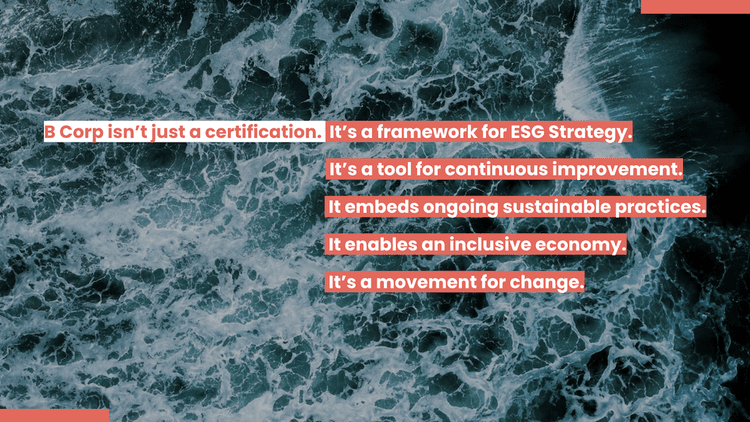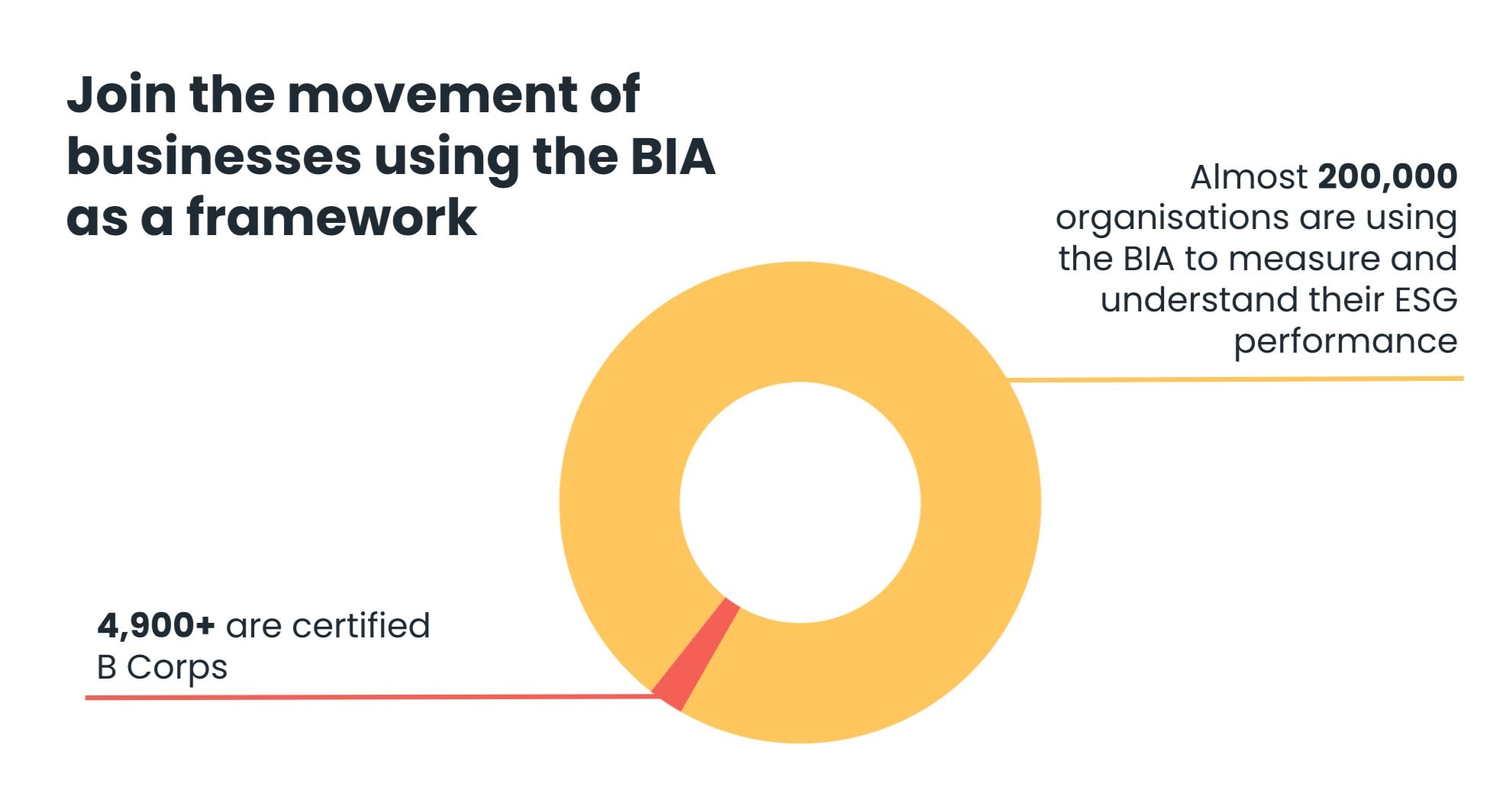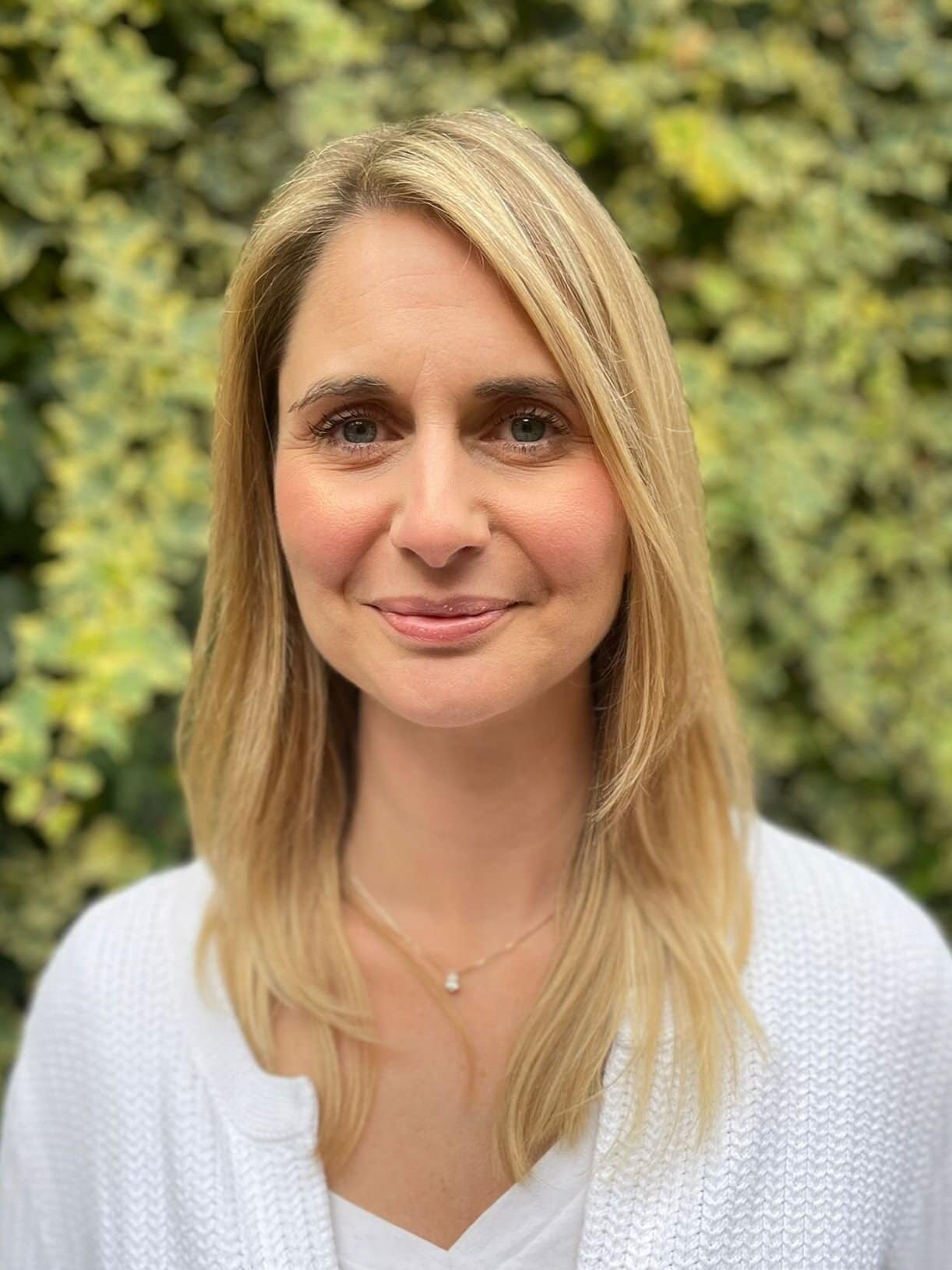
At Seismic, we believe B Corp isn’t just a certification; it’s a framework for ESG Strategy.
We held a breakfast briefing for our growing community on how to use the B Impact Assessment (BIA) as the basis for a solid sustainability strategy. We share highlights with you here.
Why B Corp?
The BIA is the online assessment tool at the heart of B Corp. It’s a tool for continuous improvement and embeds ongoing sustainable practices into your business.
Did you know that almost 200,000 organisations are using the BIA to measure their ESG performance? Of those 200,000 businesses, only 4,900+ are certified B Corps. At Seismic we use B Corp beyond certification.

4 practical steps to use the BIA to establish a sustainability strategy
- Set your ambition level
Establish where you are in terms of your impact and sustainability levels as a business and set a goal of where you want to be. - Conduct an assessment of your current ESG performance using the BIA
Complete the BIA to “scan” your business and understand your baseline performance versus other businesses. - Overlay a Materiality Assessment
A Materiality Assessment informs where to invest your energy and time, helping you to understand what areas of the BIA to prioritise. Read more about Materiality Assessments here. - Embed and continuously monitor
Ensure the BIA is lived and breathed across the organisation – at a senior leadership level, a team level and an individual level.
Insights from PZ Cussons
PZ Cussons were already doing independent sustainability projects, but it wasn’t until they made a commitment to becoming a B Corp by 2026 that they had a framework to work to. At the Seismic Breakfast Briefing we heard from Joanna Gluzman, Chief Sustainability Officer at PZ Cussons, on how they are using the BIA to inform their sustainability strategy:
“We set our ambitions high but needed a strategy to get there. We used the BIA and our Materiality Assessment to create a framework.”
The Materiality Assessment was ideal to help PZ Cussons prioritise. The BIA helped them define a best practice approach.
As a starting point, they filled in the BIA for their UK market as a litmus test to see where they sat. Their score was higher than they thought it would be, but not yet enough for submission. But it gave them a benchmark and identified where they needed to improve. Working with Seismic they’ve now implemented an improvement plan.
“One of the advantages of the B Corp framework is that it’s globally recognised, and I can’t think of any other certification that is that global. Which means that all our different markets are familiar with it and are motivated to achieve it.”
Joanna used the BIA to develop a sustainability strategy and then gave autonomy to each market to implement it in their own way: “You can really choose the parts of the BIA that are relevant to that particular market.” For example, in the UK, a key focus was waste but for other markets it was community.
“B Corp is so valuable for two things. It gives you a framework and a structure, and the certification gives you a rubber stamp to show you are definitely doing what you say.”
Joanna concluded with her long term ambitions for PZ Cussons’ sustainability strategy: “My ambition is to set our goals in an achievable and challenging way all the way to 2050 – that we stick to them, that we measure our impact, and that we inspire our customers. So beyond B Corp, our aim is to develop ourselves to be a better company and better for everyone.”
Q&A
Questions from Seismic’s Breakfast Briefing, answered by Amy Bourbeau, Chief Impact Officer and Cofounder at Seismic, and Joanna Gluzman, Chief Sustainability Officer, at PZ Cussons.

Q: Where should you start on the B Impact Assessment?
Start out with a cross-section of the assessment, rather than choosing one section or another. At Seismic, for companies on their first step, we select about 25% of the assessment from each of the 5 BIA pillars so you can see in a snapshot where you stand across your business and across all areas of impact.
Alongside the BIA we advise you to conduct a Materiality Assessment, to see what areas matter to your stakeholders, as it will help you to focus on what is actually a priority for your businesses.
Q: How does PZ Cussons marry up being a corporate manufacturer with the environmental goals you set?
It’s definitely a challenge producing a product as we do produce emissions, we do use packaging, and we do have waste. But as a manufacturer, we have to transform the way we do business. We have to work hard to make a positive impact.
Q: Why did PZ Cussons choose B Corp over other frameworks?
I don’t see it as picking one framework over others as they’re not the same. GRI is aimed at the investor community, it’s not for consumers. Consumers really understand B Corp. So it depends where you want to go. We’re aligning with Science-Based Targets and Ellen MacArthur, we may also decide to align our reporting with GRI or the Sustainable Development Goals. It is important for us to create consumer confidence that we are doing what we say we are doing. B Corp does this.
Q: When you are setting KPIs at the team and individual level, do you have any examples of what worked really well?
You will need to create a mix of targets and goals for different people. Some departments and individuals are going to have roles that are suited to reduction based targets e.g. a Facilities Manager would be set goals to reduce energy and water use, or someone from Product Development could work to improve packaging. Other teams are going to be less tangible and less obviously linked to ESG, such as people in accounts or customer care. For them you’d think about the impact they have in their role – e.g. paying suppliers on time or gathering feedback from the customers they speak to.
At innocent drinks, one of Seismic’s clients, they give people an internal B Corp role – being an agitator or an advocate – encouraging their teams to behave in the right way when engaging with various stakeholders.
Finally, make sure that senior management is incentivised with long term goals and remuneration as this will cascade down to teams and individuals.
Q: What is the B Corp guidance for startups so we can get systems in place as we go along as opposed to retrospectively changing things to certify?
Seismic just had its first birthday and we have just been certified as a B Corp, so we can talk about this from direct experience! It’s often the ideal situation to be in so you can build it from the ground up. It’s a similar process for both startups and established business, but as a startup you can be agile.
Fill in the BIA as a starting point, but prioritise and set goals as you go that reflect where you want the business to go, so that as you grow you have the right systems already in place. Decide which goals to tackle now and which to set for 3 to 5 years ahead; establishing the right pathways now will make those goals achievable when the time comes.
Read more of Seismic’s Frequently Asked Questions on B Corp.
Are you ready for B Corp certification?
Find out if your company is ready to start its B Corp journey and get tips for a successful certification.

